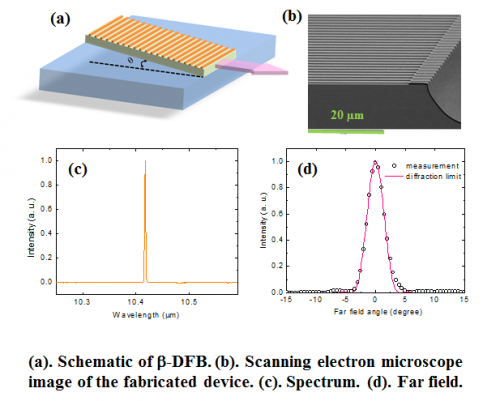Researchers develop simplified approach for high-power, single-mode lasers

(Phys.org)—When it comes to applications like standoff sensing—using lasers to detect gas, explosives, or other materials from a safe distance—the laser's strength is of the utmost importance. A stronger and purer beam means devices can sense danger more accurately from a greater distance, which translates into safer workers, soldiers, and police officers.
Northwestern University researchers have developed a new resonator that creates the purest, brightest, and most powerful single-mode quantum cascade lasers yet at the 8-12 micron range, a wavelength of great interest for both military and industrial use.
A paper describing the findings, "Angled Cavity Broad Area Quantum Cascade Lasers," was published August 21 in the journal Applied Physics Letters.
Infrared radiation in the 8-12 micron range is of interest for military and industrial use equally, as almost all chemicals (including nerve gases and toxic industrial chemicals) can be identified by infrared absorption in this range. In addition, the atmosphere is relatively transparent in this wavelength range, which allows for sensing from a distance.
But to be successful, standoff sensing applications require that laser sources be high-powered, single-mode, and possess good beam quality. Incorporating all three qualities in a single device is a significant challenge, and many sophisticated structures have been proposed with little success.
Manijeh Razeghi, Walter P. Murphy Professor of Electrical Engineering and Computer Science in the McCormick School of Engineering and Applied Science, and her group have created a new laser technology that controls both wavelength and beam quality. The feat is achieved through the use of a new type of "distributed feedback" mechanism called Β-DFB, a simple diffractive feedback in an angled laser cavity.
"Our resonator is the most promising device for creating high-power, single-mode laser sources with good beam quality, and it is inexpensive and can be realized at room temperature," said Razeghi, who leads the Center for Quantum Devices (CQD). "Furthermore the design can be applied to a wide range of semiconductor lasers at any wavelength."
Razeghi and her group demonstrated >6 watts of peak power with nearly diffraction-limited beam quality at a wavelength of 10.4 microns—the highest power single-mode semiconductor laser demonstrated at a wavelength greater than 10 microns. Refinement of the design, particularly related to optimization of the laser cavity design and improvement of the gain medium, are expected to increase the output power significantly.
The development of the Β-DFB is complementary to active research efforts within CQD, but is not yet directly funded.
Journal information: Applied Physics Letters
Provided by Northwestern University














